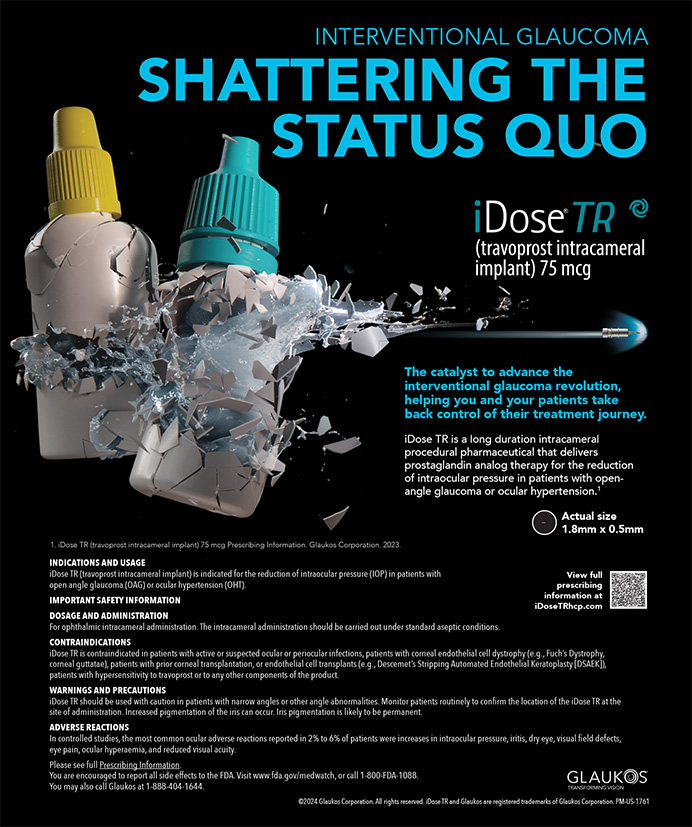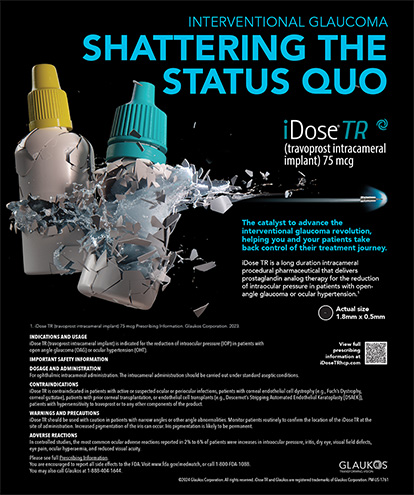Surgical skill is just one of many factors in optimizing patients' outcomes after cataract surgery. During the pre- and postoperative evaluations there are numerous interventions that can have a profound effect on postoperative visual acuity. This statement is particularly true for patients who receive presbyopia-correcting IOLs, because these individuals require extra attention to satisfy their typically high visual demands. Not only are these patients paying out of pocket, but these lenses require a healthy ocular surface, clear capsule, cornea, and macula as well as minimal residual refractive error in order to perform well. Attention to the ocular surface will help you to maximize success.
EVALUATE THE OCULAR SURFACE
During the initial consultation, it is important that you not focus solely on the cataract. Be sure to carefully evaluate the ocular surface and lid margin, because dry eye and blepharitis can worsen during the postoperative period if not addressed. A study by Calvin Roberts, MD, looked at the impact of cataract surgery on dry eye.1 He demonstrated that those patients' dry eye symptoms worsened when they instilled artificial tears alone but not when they used topical cyclosporine. Anecdotally, I have also noticed that blepharitis can worsen in some patients following cataract surgery if the condition is not addressed during the early postoperative period.
A proactive approach to these conditions is important. Eric Donnenfeld, MD, found that patients undergoing cataract surgery with multifocal IOLs achieved a better quality of vision when they were treated with topical cyclosporine b.i.d. 2 weeks preoperatively and for 2 months following surgery compared to artificial tears.2
IDENTIFY DRY EYE AND/OR BLEPHARITIS
I find that identifying patients with dry eye or blepharitis starts with a thorough history. I ask questions that are virtually identical to those I ask of patients who are interested in LASIK. As noted by Dr. Donnenfeld, this approach makes sense, because cataract surgery has evolved from a rehabilitative to a refractive procedure.
I inquire about patients' use of contact lenses, because approximately 50% of contact lens wearers have some degree of dry eye. Additionally, I ask patients whether they are taking medications that are associated with dry eye such as oral antihistamines and/or antidepressants. I also ask if they have undergone laser vision correction.
ASSESS THE TEAR FILM
At the slit lamp, I carefully look for a reduced tear film volume. I also assess the amount of fluorescein staining on the cornea and measure the tear breakup time. I inspect the lid margin for anterior blepharitis and press on the upper eyelids to assess the quality of the meibomian gland secretions. Other useful tests include corneal and conjunctival staining with lissamine green dye and a Schirmer test with anesthesia.
TREAT DRY EYE AND BLEPHARITIS
Between the history and tests, I can determine whether patients considering cataract surgery have preexisting dry eye, blepharitis, or both. For those with a reduced tear film, tear volume, and other signs of dry eye, I prescribe a pulse of Pred Forte 1% (prednisolone acetate; Allergan, Inc., Irvine, CA) for 1 week in addition to long-term Restasis drops (Allergan, Inc.) b.i.d. In contrast, if the patient's eyelids are involved and there is obvious blepharitis, I will prescribe AzaSite (azithromycin; Inspire Pharmaceuticals, Inc., Durham, NC) q.h.s. and warm compresses, based on work by a number of surgeons, including Jodi Luchs, MD, and Thomas John, MD.3,4 For severe meibomian gland dysfunction, I sometimes add a pulse of topical steroids to the regimen of AzaSite and warm compresses. Some patients have dry eye and blepharitis. In these cases, I prescribe prednisolone acetate 1% q.i.d., cyclosporine 0.05% b.i.d., and topical azithromycin q.h.s. I may also recommend oral omega-3 supplements, as there is some evidence that this fatty acid can improve both blepharitis and dry eye.5
Most importantly, my patients return to the office prior to surgery for repeat imaging with the IOLMaster (Carl Zeiss Meditec, Inc., Dublin, CA) and topography. The aforementioned therapy should have improved the tear film and therefore permit better keratometry readings. The latter are important to IOL power calculations as well as the determination of the axis and magnitude of astigmatism for either limbal relaxing incisions or toric IOLs. Repeat testing can really improve patients' visual outcomes. For example, a patient presents with a topographic map that looks like forme fruste keratoconus with significant inferior steepening (Figure 1A). This patient had both dry eye and blepharitis, and the topography is actually inaccurate due to the poor tear film. I initiated cyclosporine b.i.d. and AzaSite q.h.s., and the patient improved during the 1 week of treatment (Figure 1B)
An evaluation of the anterior segment of the eye prior to surgery does not stop with the tear film. Recently, I examined a patient who was disappointed with his vision after cataract surgery with a presbyopia-correcting IOL. The Crystalens (Bausch & Lomb, Inc., Rochester, NY) was in perfect position, and optical coherence tomography showed a normal macula. The slit-lamp examination revealed epithelial basement membrane dystrophy (EBMD) (Figure 2), which reduced his BCVA to 20/40. Establishing the issues that can affect visual outcomes is critical to counseling patients preoperatively. Otherwise, they may assume that their reduced postoperative vision is the result of problems during the cataract procedure and blame the surgeon. In this case of EBMD, the patient is scheduled for a superficial phototherapeutic keratectomy to remove the irregular epithelium and allow for the return of a smoother corneal surface.
CONCLUSION
Identifying preexisting conditions such as EBMD and epiretinal membranes allows you to adjust patients' expectations for surgery appropriately. Although current technology enables cataract surgeons to deliver excellent visual results, a flawless procedure can be dramatically compromised by untreated dry eye disease or blepharitis. Evaluating patients' ocular surface and lid margin and treating their dry eye disease and/or blepharitis, if present, can significantly improve their visual outcome.
William B. Trattler, MD, is a corneal specialist at the Center for Excellence in Eye Care in Miami. He has received funding for research, consulting, and/or speaking from Allergan, Inc., and Inspire Pharmaceuticals, Inc. Dr. Trattler may be reached at (305) 598-2020; wtrattler@earthlink.net.
- Roberts CW, Elie ER. Dry eye symptoms following cataract surgery. Insight. 2007;32(1):14-21.
- Donnenfeld E, Roberts C, Perry H, et al. Efficacy of topical cyclosporine versus tears for improving visual outcomes following multifocal IOL implantation. Paper presented at: The ASCRS/ASOA Symposium on Cataract, IOL and Refractive Surgery; April 2006; San Diego, CA.3. Luchs J. Efficacy of topical azithromycin ophthalmic solution 1% in the treatment of posterior blepharitis. Adv Ther. 2008;25(9):858-870.
- John T, Shah AA. Use of azithromycin ophthalmic solution in the treatment of chronic mixed anterior blepharitis. Ann Ophthalmol (Skokie). 2008;40(2):68-74.
- Miljanovi B, Trivedi KA, Dana MR, et al. Relation between dietary n-3 and n-6 fatty acids and clinically diagnosed dry eye syndrome in women. J Clin Nutr. 2005;82(4):887-893.


